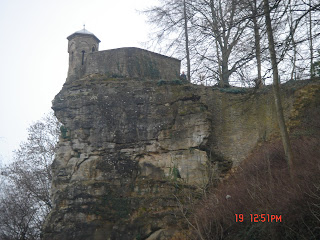
After our day in Belgium we drove home through Luxembourg - stopping for the day in Luxembourg City. We were amazed by Luxembourg City! It was much more than we expected! The weather was very warm - we hardly needed coats but it was hazy to foggy all day so some of the pictures are not as clear as we would have liked.

Luxembourg is often called the Gibraltar of the north because of its extremely secure and complex fortifications. The city began when Count Siegfried built a fortress, surrounded by a rather simple fortification on the Bock promontory in 963. Over many years a second and then a third fortification were built on the west side. The deep valleys of Petrusse and Alzette provided natural protection on the other side. In spite of its well-chosen location and extensive fortifications, Luxembourg did not go undisturbed. It was taken by surprise in 1443 by the Burgundians and others including the Germans during WWII.
The Burgundians, the French, Spain, Austria and Germany all called Luxembourg City theirs at one time and contributed to its status as one of the mightiest emplacements in the world. The city is defended by three "layers" of battlements. The inner is fortified with bastions, the second included 15 forts and the third was composed of an outer wall containing 9 forts, all of which were built into the rock. It also has a network of 23 km of underground tunnels (the casements) and more than 40,000 sq meters of bombproof rooms cut into the rock on which the city is built! These rooms sheltered people, equipment, horses, workshops, kitchens, bakeries, etc. So a lot of what we saw were these walls, the valley, bridges over the valley, the tunnels in the rock, etc. It was all beautiful - and amazing feats of engineering!

We started at the Statue of William II erected in honor of the King and Grand Duke William II of Orange-Nassau who ruled from 1840-1849. The statue sits in a large city square (William Square) around which many government buildings can be found.



The hike through "Old Town" was amazingly steep! We got quite a workout!
This is St. Michael's Church - the oldest in the city. The site originally held the castle chapel of the Counts of Luxembourg (built in 987). Several churches, including the castle chapel, on this site were destroyed over the years. St. Michael's Church dates to 1688 with restorations in the 1960's and 1980's.
This is St. John on the Stone dating from at least 1309 and the Neumunster Abbey.

This is the Bock Prometory. It served as the cradle of the city built here when Siegfried, Count of Ardenne, aquired this massive rocky ledge from the Saint Maximin Abbey in Trier. Again, this location was important in the defense of the city. The promontory is surrounded on three sides by the Alzette Valley so it was approachable only from the west.
Here we visited the archeological crypt where the origins of the city are being excavated. We also toured the casemates - complex an

d extensive series of tunnel and rooms carved out of the rock of the prometory. They were first built in the 1600's when the Spanish controlled Luxembourg. They were enlarged by other controlling powers through the years. They consist of 23 km of tunnels, reaching a depth of 40 meters.











Our last stop before setting the navigation system to "home" was two WWII cemeteries just outside of Luxembourg City. One is an American WWII memorial and cemetery and the other a German WWII cemetery and memorial. This is the gate to the American WWII memorial and cemetery. It is one of 14 WWII cemeteries on foreign soil. This site was liberated by the US 5th Armored Division on September 10, 1944 and soonafter, a temporary military burial ground was established here. The graves contain the remains of 5075 men and 1 woman who died in WWII. 101 headstones mark graves of those whose remains could not be positively identified.

Two large pylons contain the names of 371 Missing in Action. All 50 states and Washington DC are represented by those buried here. Many of the graves hold soldiers who died in the Battle of the Bulge.

This cemetery also contains the grave of General Patton, buried here

at his request.





Needless to say it is a sobering and humbling experience to walk these grounds.
Just a few kilometers away, in a poignant reminder of the futility of war, is a German WWII cemetery - Sandweiler. 10,914 German
soldiers of WWII are buried here - most 2 or 3 to a marker and 4829 in a mass grave. The remains of 810 soldiers were never identified.




What a great two days! But now it was time to head home. Set the navigation system for Heidelberg!








































 After our day in Belgium we drove home through Luxembourg - stopping for the day in Luxembourg City. We were amazed by Luxembourg City! It was much more than we expected! The weather was very warm - we hardly needed coats but it was hazy to foggy all day so some of the pictures are not as clear as we would have liked.
After our day in Belgium we drove home through Luxembourg - stopping for the day in Luxembourg City. We were amazed by Luxembourg City! It was much more than we expected! The weather was very warm - we hardly needed coats but it was hazy to foggy all day so some of the pictures are not as clear as we would have liked.










































































